What ocular structure d Study guides, Class notes & Summaries
Looking for the best study guides, study notes and summaries about What ocular structure d? On this page you'll find 550 study documents about What ocular structure d.
Page 4 out of 550 results
Sort by

-
OptoPrep NBEO Practice Questions& answers 2023/24 | with complete solution
- Exam (elaborations) • 42 pages • 2023
-
- $10.49
- + learn more
OptoPrep NBEO Practice Questions& answers 2023/24 | with complete solution If a thin lens with an index of 1.5 has a dioptric power of +4.00 in air, what is its power if placed in water? A) +1.18 diopters B) +11.76 diopters C) +1.36 diopters D) +4.00 diopters - C) +1.36 diopters Alpha helices and beta sheets are considered which level of protein structure? A) Quaternary B) Primary C) Tertiary D) Secondary - D) Secondary An amphipathic molecule will react in what manner when e...
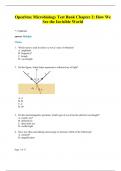
-
OpenStax Microbiology Test Bank Chapter 2: How We See the Invisible World
- Exam (elaborations) • 17 pages • 2024
- Available in package deal
-
- $18.50
- + learn more
OpenStax Microbiology Test Bank Chapter 2: How We See the Invisible World * = Correct answer Multiple Choice 1. Which term is used to refer to a wave’s rate of vibration? A. amplitude B. frequency* C. trough D. wavelength 2. On the figure, which letter represents a refracted ray of light? A. A B. B C. C D. D* 3. On the electromagnetic spectrum, which type of wave has the shortest wavelength? A. cosmic ray* B. infrared ray C. ultraviolet ray D. visible light ...
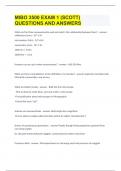
-
MIBO 3500 EXAM 1 (SCOTT) QUESTIONS AND ANSWERS
- Exam (elaborations) • 26 pages • 2023
-
- $14.49
- + learn more
What are the three measurements used and what's the relationship between them? millimeters (mm) - 10^-3 M micrometers (Mm) - 10^-6 M nanometers (nm) - 10^-9 M 1000 nm = 1 Mm 1000 Mm = 1 mm Humans can see up to what measurement? ~100-200 Mm What are three contradictions to the definition of a microbe? Supersize microbial cells, Microbial communities, and viruses What are Robert Hooke - Built the first microscope - First to observe mold, fleas, and cork under a micro...
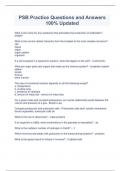
-
PSB Practice Questions and Answers 100% Updated
- Exam (elaborations) • 16 pages • 2023
-
- $11.49
- + learn more
What is the name for any substance that stimulates the production of antibodies? - antigen What is the correct cellular hierarchy from the simplest to the most complex structure? - cell tissue organ organ system organism If a cell is placed in a hypertonic solution, what will happen to the cell? - It will shrink. What are major parts and organs that make up the immune system? - lymphatic system spleen tonsils thymus bone marrow The rate of a chemical reaction depends on all t...
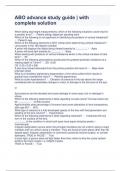
-
ABO advance study guide | with complete solution
- Exam (elaborations) • 25 pages • 2023
-
- $11.99
- + learn more
ABO advance study guide | with complete solution When taking seg height measurements, which of the following situations could result in a parallax error? - Patient sitting/ dispenser standing erect Which of the following is not significant in identifying the problem of vertical imbalance? - Patient's age Which of the following elements is NOT critical when determining vertical imbalance? - Lens power in the 180 degree meridian A prism will displace the object being viewed toward...
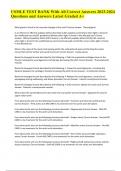
-
USMLE TEST BANK | Questions and Answers Latest Update Graded A+
- Exam (elaborations) • 236 pages • 2023
- Available in package deal
-
- $19.49
- + learn more
USMLE TEST BANK | Questions and Answers Latest Update Graded A+. What is the name of the spinal cord passing within the subarachnoid space and forming the spinal nerves that exit the lumbar and sacral foramina? Correct Answer: Cauda equina Name the laryngeal muscle described by the following: • Pulls the arytenoids cartilages closer to the thyroid, relaxing the vocal ligaments and thereby decreasing the pitch Correct Answer: Thyroarytenoid muscles Name the laryngeal muscle described by th...
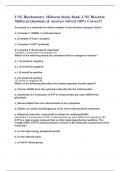
-
UNE Biochemistry Midterm Study Bank, UNE Biochem Midterm Questions & Answers Solved 100% Correct!!
- Exam (elaborations) • 28 pages • 2024
-
- $14.49
- + learn more
UNE Biochemistry Midterm Study Bank, UNE Biochem Midterm Questions & Answers Solved 100% Correct!! Succinate is a substrate for which complex in the electron transport chain? a.) Complex 1 (NADH-1 oxidoreductase) b.) Complex IV (Cyt c oxidase) c.) Complex V (ATP synthase) d.) complex II (Succinate-Q reductase) Complex II (succinate-Q reductase) (D) Which of the following would be consistent with an exergonic reaction? a.) ∆S would be negative b.) ∆G would be negative ...
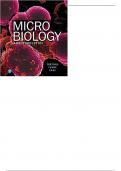
-
Microbiology 13th Edition BY Tortora - Test Bank
- Exam (elaborations) • 560 pages • 2023
-
- $23.80
- + learn more
Microbiology: An Introduction, 13e (Tortora et al.) Chapter 2 Chemical Principles 2.1 Multiple-Choice Questions 1) Which of the following statements about the atom is C FALSE? A) It has 6 protons in its nucleus. B) It has 12 neutrons in its nucleus. C) It has 6 electrons orbiting the nucleus. D) Its atomic number is 6. E) Its atomic weight is 12. Answer: B Section: 2.1 Bloom's Taxonomy: Understanding Learning Outcome: 2.1 Global Outcome: 2 2) Table 2.1 O C H ...
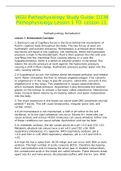
-
WGU Pathophysiology Study Guide: D236 Pathophysiology Lesson 1 TO Lesson 11
- Class notes • 28 pages • 2022
-
Available in package deal
-
- $13.50
- 4x sold
- + learn more
WGU Pathophysiology Study Guide: D236 Pathophysiology Lesson 1 TO Lesson 11 WGU Pathophysiology Study Guide: D236 Pathophysiology Lesson 1 TO Lesson 11: Pathophysiology Remediation Lesson 1: Homeostasis Concepts 1. Starling's Law of Capillary forces is the force behind the movements of fluid in capillary beds throughout the body. The two forces at work are hydrostatic and osmotic pressures. Homeostasis is achieved when these two forces are equal in the capillary- cell interfaces. When...

-
USMLE TEST BANK With All Correct Answers 2023-2024 | Questions and Answers Latest Graded A+
- Exam (elaborations) • 236 pages • 2023
-
Available in package deal
-
- $18.49
- + learn more
USMLE TEST BANK With All Correct Answers 2023-2024 | Questions and Answers Latest Graded A+. What gland is found in the muscular triangle of the neck? Correct Answer: Thyroid gland Is an afferent or efferent pupillary defect described as B/L pupillary constriction when light is shined in the unaffected eye and B/L paradoxical dilation when light is shined in the affected eye? Correct Answer: Afferent pupillary defect (CN II lesion); in an efferent pupillary defect (CN III), B/L constrict whe...

$6.50 for your textbook summary multiplied by 100 fellow students... Do the math: that's a lot of money! Don't be a thief of your own wallet and start uploading yours now. Discover all about earning on Stuvia


